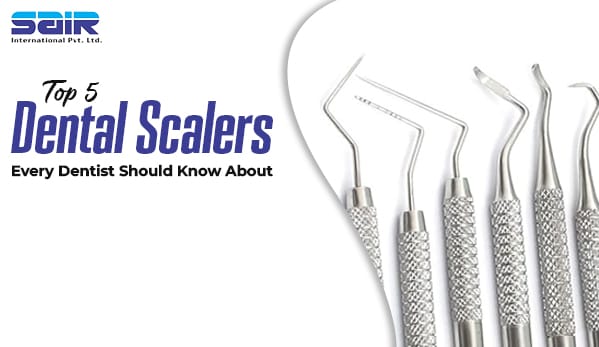Dental scaling is a cornerstone of effective oral hygiene and preventive dentistry. As a dentist, understanding and utilizing the right scalers can significantly impact the quality of care you provide to your patients. With various types of dental scalers available, it can be overwhelming to determine which ones are essential for your practice. To simplify the process, we’ve compiled a list of the top 5 dental scalers that every dentist should be familiar with. These tools are not only efficient but also designed to meet the diverse needs of your patients.
1. Sickle Scalers
Sickle scalers are one of the most commonly used tools in dental hygiene. They are easily recognizable by their sharp, curved blades and pointed tips. These features make them highly effective in removing supragingival calculus (tartar) from the surfaces of teeth.
Key Features:
- Design: A curved blade with two cutting edges and a pointed tip.
- Functionality: Ideal for cleaning areas between teeth and along the gum line.
- Efficiency: Works best for heavy calculus deposits on the crowns of teeth.
Common Types:
- H6/H7 Scaler: Excellent for anterior teeth.
- 204S Scaler: Preferred for posterior teeth.
Sickle scalers are one of dental scalers which are particularly useful for removing debris in hard-to-reach areas, such as between tightly spaced teeth. Their sharpness ensures precise removal of deposits, but they require careful handling to avoid causing trauma to soft tissues.

2. Curettes
Curettes are indispensable for subgingival scaling and root planing. Unlike sickle scalers, curettes have a rounded tip and are designed for deep cleaning beneath the gum line without causing damage to surrounding tissues.
Key Features:
- Design: Rounded toe and blade with a semicircular cross-section.
- Functionality: Effective for removing subgingival calculus and smoothing root surfaces.
- Versatility: Can be used on all tooth surfaces.
Types of Curettes:
- Gracey Curettes: Area-specific instruments designed for specific teeth and surfaces (e.g., Gracey 1/2 for anterior teeth, Gracey 11/12 for mesial surfaces of posterior teeth).
- Universal Curettes: Designed for use on all teeth and surfaces (e.g., Columbia 13/14).
Gracey curettes are particularly favored in periodontal therapy for their precision and adaptability, while universal curettes are great for general use.
3. Ultrasonic Scalers
Third kind of Dental Scaler is Ultrasonic scalers that have revolutionized dental hygiene by providing a faster and less labor-intensive method of removing calculus and biofilm. These scalers use high-frequency vibrations to break down deposits, making them highly effective and less uncomfortable for patients.
Key Features:
- Technology: Utilizes ultrasonic vibrations (25,000–30,000 cycles per second).
- Water Flow: Integrated irrigation system to cool the tip and flush out debris.
- Efficiency: Reduces hand fatigue and speeds up the scaling process.
Common Types:
- Magnetostrictive Scalers: Produce elliptical vibrations and can be used on all sides of the tip.
- Piezoelectric Scalers: Generate linear vibrations, offering more precision.
Ultrasonic scalers are ideal for patients with extensive tartar buildup and are particularly useful in periodontal treatments. However, their use requires proper training to avoid enamel damage.
4. Hoe Scalers
Hoe scalers are less commonly used but are invaluable for removing tenacious calculus deposits. Their flat blade with a beveled edge is designed to scrape off heavy deposits effectively.
Key Features:
- Design: Flat blade set at a 99-degree angle to the shank.
- Functionality: Best for large, stubborn deposits on the buccal and lingual surfaces of teeth.
- Strength: Requires firm pressure for optimal results.
Hoe scalers are particularly useful in cases where manual scaling is required for significant tartar buildup. They are often used in combination with other scalers for comprehensive cleaning.

5. Chisel Scalers
Chisel scalers are another specialized tool that every dentist should consider having in their arsenal. They are designed for removing interproximal calculus from anterior teeth.
Key Features:
- Design: Straight blade with a beveled edge.
- Functionality: Best for pushing or pulling strokes to dislodge deposits.
- Application: Works well in areas with open embrasures.
While not as versatile as other dental scalers, chisel scalers excel in their specific application. They are particularly effective in anterior regions where access is less restricted.
Choosing the Right Scaler
The choice of dental scalers depends on several factors, including the patient’s oral condition, the location of deposits, and the type of procedure being performed. Here are some tips to help you select the right scaler:
- Assess the Patient’s Needs: Evaluate the extent and location of tartar buildup.
- Consider Comfort and Efficiency: Use ultrasonic scalers for extensive deposits and manual scalers for precision work.
- Combine Tools: Utilize a combination of scalers to ensure thorough cleaning.
- Prioritize Ergonomics: Choose tools with comfortable grips to reduce hand fatigue during long procedures.
Maintenance and Care of Dental Scalers
Proper maintenance of your scalers is crucial to ensure their longevity and effectiveness. Here are some tips:
- Sharpen Regularly: Keep manual scalers sharp to maintain their cutting efficiency.
- Sterilize Properly: Follow recommended sterilization protocols to prevent cross-contamination.
- Inspect Frequently: Check for signs of wear and replace damaged instruments.
Conclusion
Dental scalers are essential tools for maintaining oral health and delivering high-quality patient care. By familiarizing yourself with the top 5 dental scalers—sickle scalers, curettes, ultrasonic scalers, hoe scalers, and chisel scalers—you can ensure that you are well-equipped to handle a wide range of dental hygiene needs. Investing in the right tools and mastering their use will not only enhance your clinical outcomes but also improve your patients’ overall experience. Stay informed, stay prepared, and continue providing exceptional dental care.


